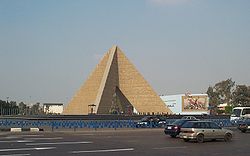Nasr City
(Arabic: مدينة نصر) is a district of Cairo, Egypt. It is located to the east of the Cairo Governorate and consists mostly of condominiums. It was established in the 1960s as an extension to neighboring suburb of Heliopolis. The establishment of the district was part of the Egyptian Government's plan to modernise and expand Cairo following the Egyptian Revolution of 1952. Gamal Abdel Nasser, the Egyptian President at the time, was involved personally in the design process, and was the one who chose the name Nasr for the new district ("nasr" being the Arabic word for "victory"). Now, Nasr City is extremely crowded, much more than was expected from the creation of the district, because of Egyptian families relocating to the district and also because of Somali and Sudanese immigration to areas of Nasr City such as Hay al Asher.
("nasr" being the Arabic word for "victory"). Now, Nasr City is extremely crowded, much more than was expected from the creation of the district, because of Egyptian families relocating to the district and also because of Somali and Sudanese immigration to areas of Nasr City such as Hay al Asher.
Nasr City is home to the new premises of Al-Azhar University, the Cairo International Conference Center, Cairo International Stadium, a branch of the Ahly Club and several government buildings. Among its major landmarks is the pyramid-like Unknown Soldier Memorial honoring the Egyptian and other Arab servicemen killed in the October War of 1973. The Memorial is opposite the grandstand at which President Sadat was assassinated, and is where Sadat himself is buried.
Cairo
It is the capital of Egypt and the largest city in the Arab world and Africa, and the 16th largest metropolitan area in the world.It is located near the Nile delta .
It is and the area around it are considered to be the heart of Egypt, and one may find almost every aspect of Egypt represented in the area, including some of the most famous Pharaonic, ancient Christian and Islamic monuments.
